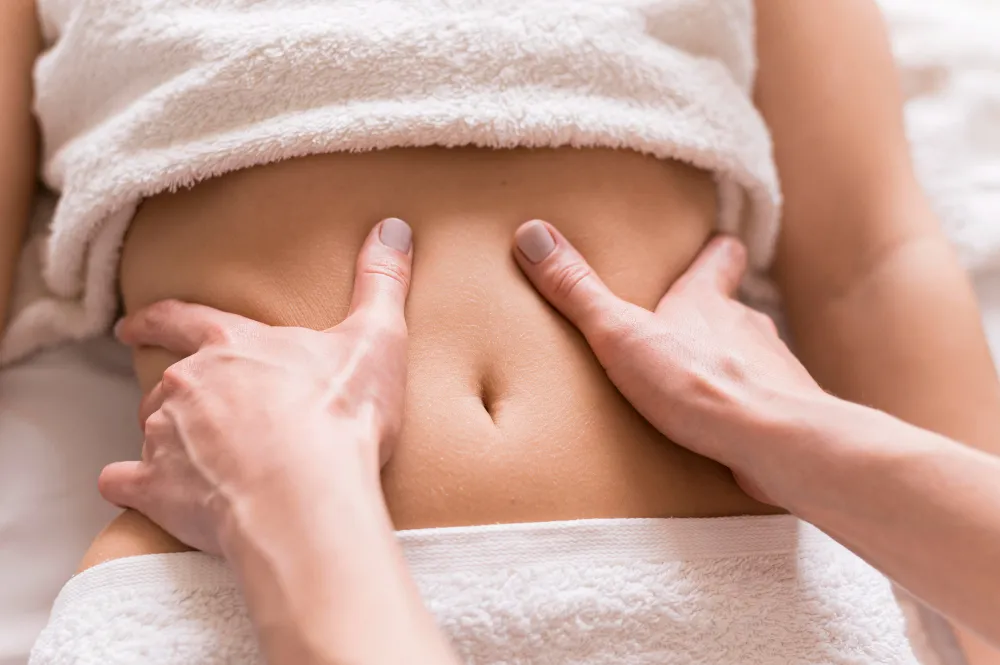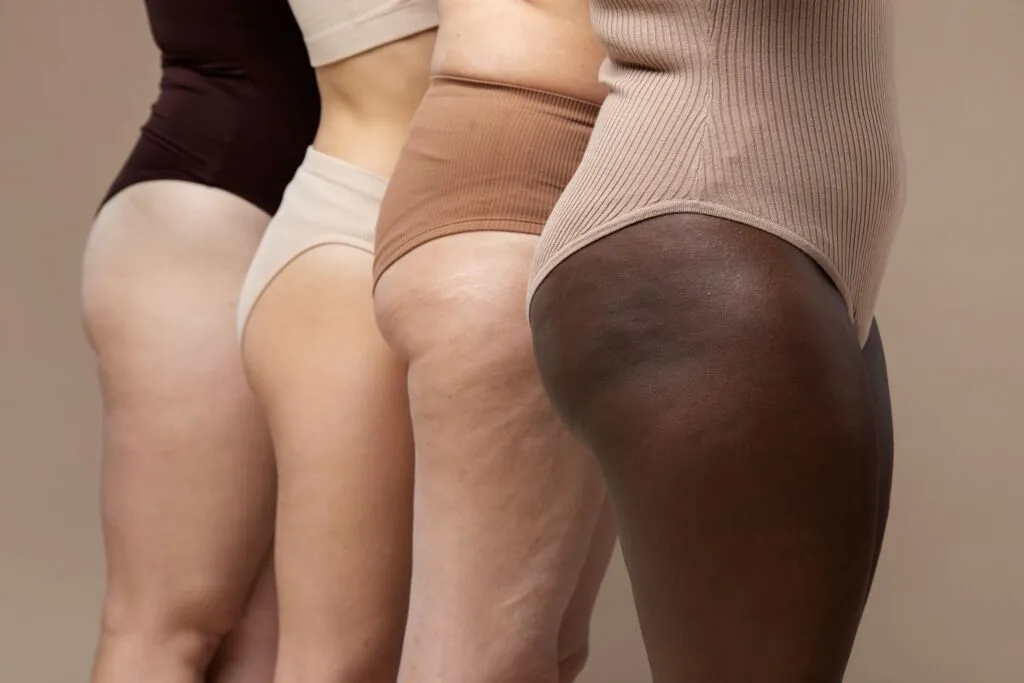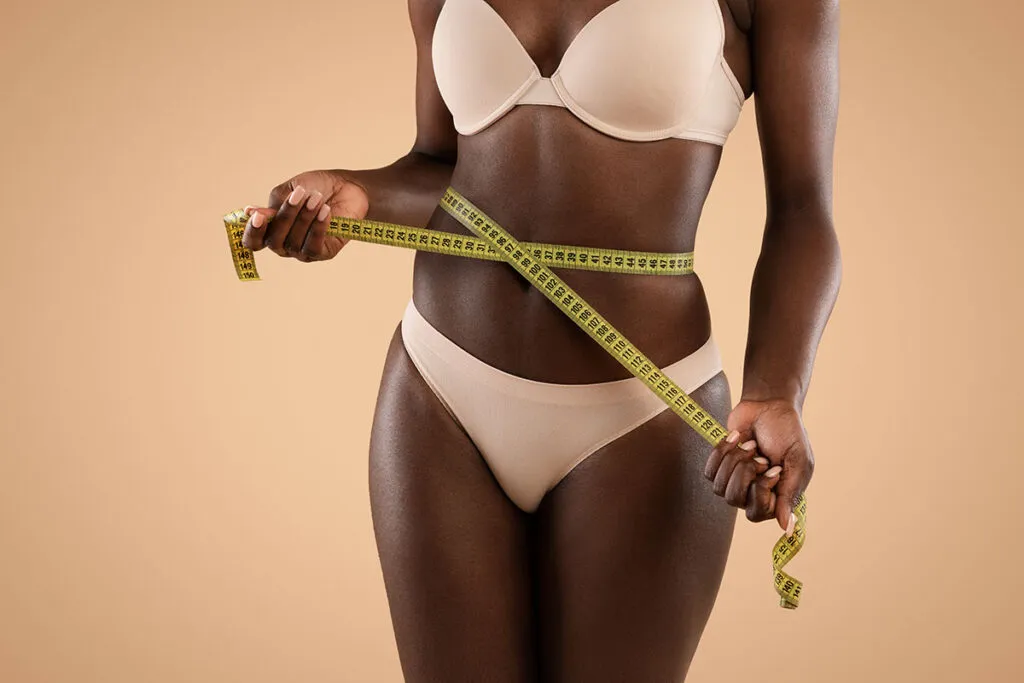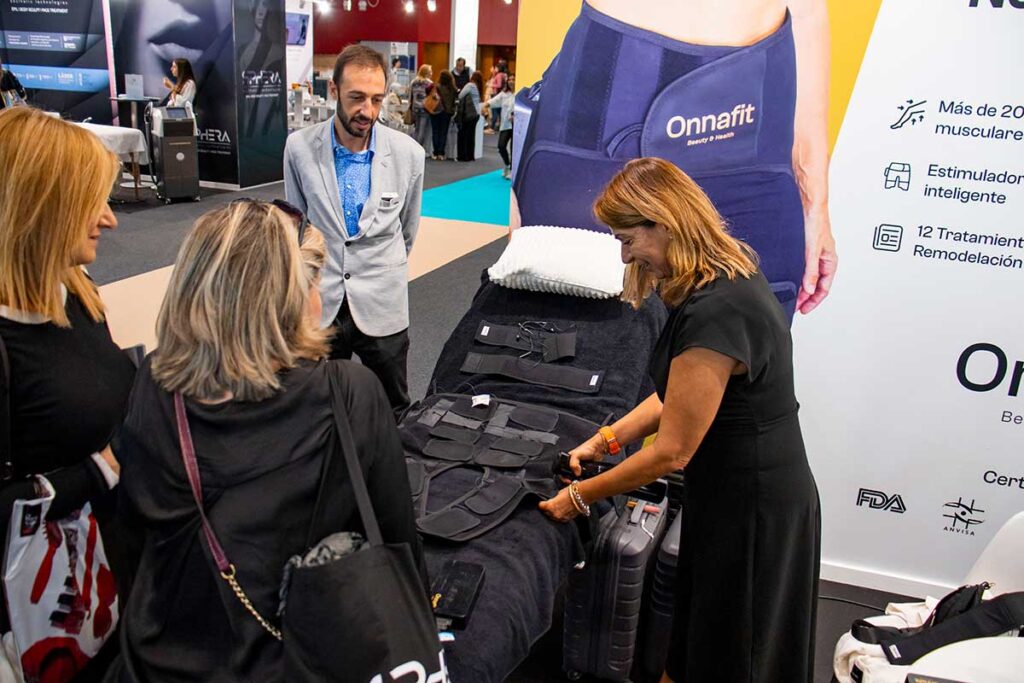Flabby arms or arm flabbiness is a more common concern than we might think for many people, especially women, and this concern affects both physical appearance and self-confidence..
Addressing arm flabbiness is important not only for aesthetic reasons but also for overall health. Strong, toned arms not only enhance appearance but can also improve daily functionality by easing tasks such as lifting heavy objects or engaging in physical activities.
In this blog, we’ll delve into what arm flabbiness are, the underlying causes, and the factors contributing to this issue. Additionally, we’ll offer practical tips and effective exercises to help you combat arm flabbiness and regain self-confidence.
What is flabby arms, and why does it occur?
Flabby arms is when there is excess loose skin and a lack of muscle tone in that specific area of the body. This problem can arise due to a variety of factors, including aging, rapid weight loss, lack of exercise and genetics:
- Aging: With the passage of time, the skin tends to lose elasticity and muscle tone tends to decrease.
- Rapid weight loss: When you lose weight quickly, the skin does not always have time to adapt and may become loose.
- Lack of exercise: Muscle tone is maintained through regular exercise, and if arm muscles are not exercised regularly, they can become flabby.
- Genetics: Some individuals may have a genetic predisposition to arm flabbiness.
- Sun exposure: Excessive sun exposure can damage the skin’s structure and contribute to sagging. UV rays can break down the skin’s collagen and elastin, leading to a loss of elasticity and firmness.
- Unhealthy lifestyle habits: Smoking, an unhealthy diet, and lack of adequate hydration can negatively impact skin health and contribute to arm flabbiness, as well as in other areas of the body.
This laxity may be most evident on the upper arm, especially in the area under the triceps, where the skin tends to bunch up and become looser over time.
Understanding these common causes of arm flabbiness is crucial for taking preventive measures and adopting a proactive approach to maintaining firm and toned skin over time. In the following sections, we’ll explore strategies for preventing and treating arm flabbiness.
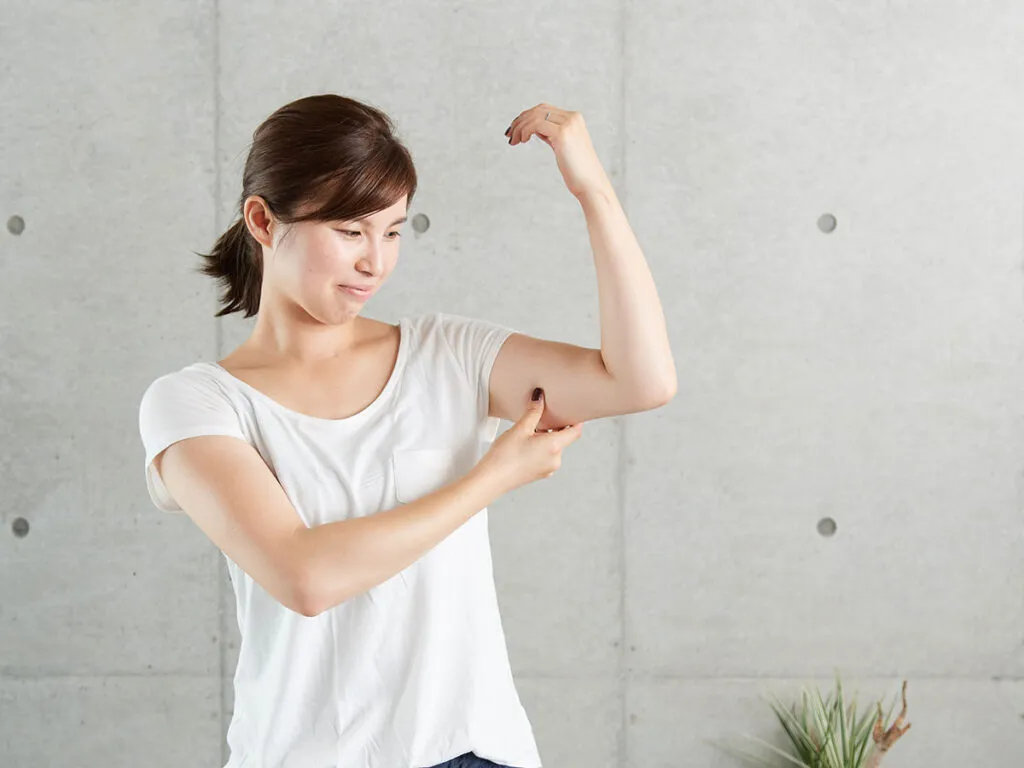
How to prevent flabby arms
Preventing arm flabbiness is possible with a comprehensive approach that includes healthy dietary habits, skincare, and overall lifestyle. Here are some useful tips:
- Balanced, high-protein diet: Eat a balanced diet that includes a variety of protein-rich foods, such as lean meat, fish, eggs, low-fat dairy products, legumes, and tofu. Protein is essential for building and repairing tissue, including muscles, which can help maintain firmness and tone in your arms.
- Essential nutrients: Make sure you get enough vitamins and minerals in your diet, especially vitamin C, vitamin E, and zinc, which They are important for the health of the skin and connective tissue. Incorporate fruits, vegetables, whole grains, and healthy fats into your diet for a wide range of nutrients.
- Adequate hydration: Drinking enough water is crucial for keeping the skin hydrated and healthy. Water helps maintain skin elasticity and prevents dryness, which can contribute to flabbiness.
- Use of firming creams: Consider using firming creams that contain ingredients such as retinol, collagen, elastin, vitamin E or hyaluronic acid. These creams can help improve skin elasticity and provide additional hydration, although results may vary and are generally most effective when combined with other approaches, such as diet and exercise.
- Avoiding excessive sun exposure: Protect your skin from sun damage by wearing sunscreen every day, even on cloudy days. Excessive sun exposure can damage the collagen and elastin in the skin, which can contribute to arm flabbiness.
- Regular exercise: In addition to a good diet, regular exercise is crucial to maintaining muscle firmness in the arms. Incorporate arm-specific strength exercises, such as push-ups, triceps dips, weight lifting, and resistance band exercises, to strengthen and tone your arms.
By adopting these tips as part of your lifestyle, you can help prevent arm flabbiness and maintain firm, toned skin over time.
Treatments to combat flabby arms
In addition to lifestyle tips and skincare, there are various aesthetic treatments that can help combat arm flabbiness. Here are some popular options, some less invasive than others
- Arm surgery: Brachioplasty is a surgical procedure used to remove excess skin and fat from the arms, especially in the inner part. During the surgery, an incision is made along the inner part of the arm to remove excess tissue and tighten the remaining skin. This procedure is more invasive and involves a longer recovery time, but it can provide significant results in reducing flabbiness.
- Liposuction: Liposuction is a procedure used to remove excess fat from specific areas of the body, including the arms. Although liposuction is not specifically designed to treat skin flabbiness, it can help improve the appearance of the arms by removing excess fat, which may reduce skin laxity to some extent.
- Laser and radiofrequency treatments: Laser and radiofrequency treatments use thermal energy to stimulate collagen production in the skin and improve its firmness. These treatments can help tighten loose skin and improve the appearance of your arms without the need for invasive surgery. Multiple sessions may be needed for optimal results, and results may vary by individual.
- Aesthetic electrostimulation: Aesthetic electrostimulation is a technique that uses low-frequency electrical currents to stimulate muscles and improve their tone and firmness. This treatment is non-invasive and does not require surgery, and it can help strengthen the arms and improve the appearance of flabby skin. It is often recommended as a complement to other treatments and a healthy lifestyle, and multiple sessions may be required to see significant results
It is important to consult with a medical or aesthetic professional to determine which treatment is most appropriate based on your individual needs and medical history. Each option has its own advantages and considerations, and a specialist will be able to provide you with personalized guidance to help you achieve your aesthetic goals.
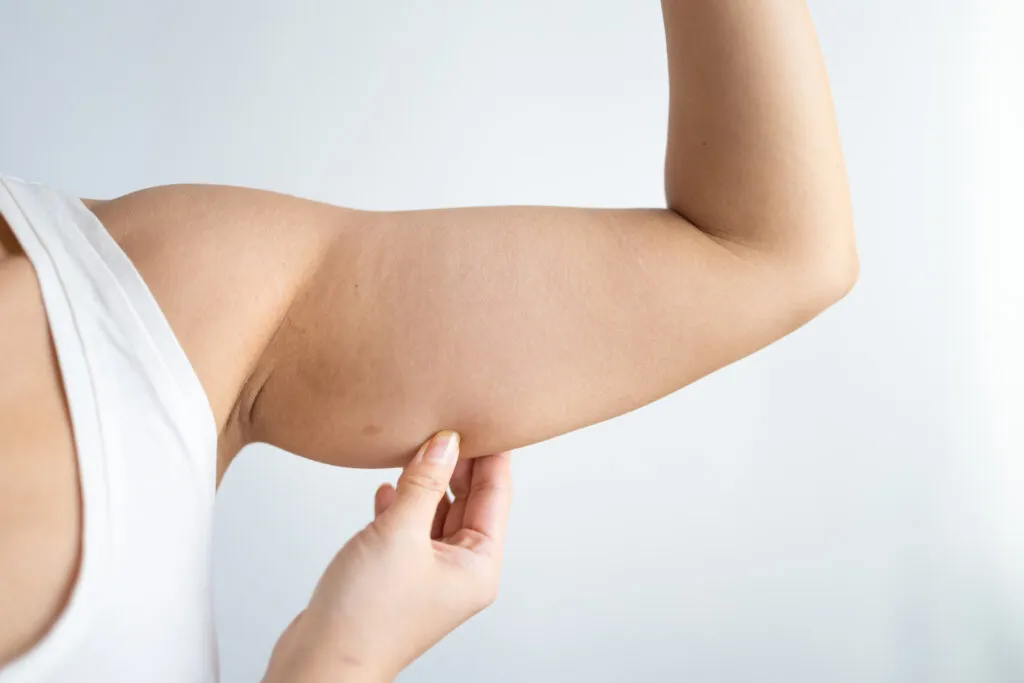
Conclusion on sagging arms
Arm flabbiness is a common concern that can affect appearance and confidence, but with the right habits, it can be prevented and improved. A balanced diet rich in protein, proper hydration, and the use of firming creams help maintain toned and elastic skin.
Since every person is different, it’s best to seek professional advice to find the most effective treatment. Combining healthy nutrition, regular exercise, and consistent skin care is the key to keeping your arms firm, defined, and full of confidence over time.
Did you like this blog? Support us and subscribe now!
Frequently Asked Questions About Flabby Arms
What is the best treatment for sagging arms?
To combat arm sagging, it’s important to combine targeted exercises with aesthetic treatments and, when necessary, surgical options. Strength-building movements such as push-ups, triceps dips, and weight training help tone the underlying muscles, reducing flaccidity and improving overall arm definition. Incorporating a regular resistance routine is key to maintaining firmness and elasticity over time.
In terms of non-invasive treatments, techniques like radiofrequency and ultrasound therapy are highly effective in stimulating collagen production, which helps tighten and rejuvenate the skin. Additionally, cryolipolysis can assist in eliminating localized fat, further enhancing the skin’s firmness and contour. Together, these methods provide visible, long-lasting results — all without the need for surgery
How can I prevent flabby arms?
- Incorporate regular strength training exercises for the arms.
- Maintain a healthy weight through a balanced diet and cardio.
- Stay hydrated to improve skin elasticity.
- Avoid significant weight fluctuations that can lead to loose skin.
Are resistance bands effective for flabby arms?
Yes, resistance bands are great for toning arms. Exercises like banded tricep extensions, bicep curls, and lateral raises are effective for building muscle and reducing the appearance of flabby arms.
Can yoga or pilates help with flabby arms?
Yes, both yoga and Pilates can be very effective in toning and strengthening the arms. These disciplines use bodyweight resistance to engage multiple muscle groups, including the shoulders, triceps, and biceps, helping to improve definition and firmness over time.
In yoga, poses such as Plank, Chaturanga, Downward-Facing Dog, and Side Plank build endurance and activate the upper body while also enhancing core stability. Pilates, on the other hand, focuses on controlled movements and mind–muscle connection, which improves posture and muscle tone without adding bulk.
When practiced consistently, both yoga and Pilates help increase muscle strength, improve circulation, and enhance flexibility, leading to tighter, more sculpted arms and an overall balanced physique. For best results, these practices can be combined with light strength training and a balanced diet to further support muscle development and skin firmness.
Best treatment for flabby arms
Flabby arms, often caused by loss of muscle tone, aging, or excess fat, can be improved with a combination of exercise, skin-tightening treatments, and a healthy lifestyle. Here are the most effective ways to tone and tighten sagging arms:
1. Strength Training (Best Long-Term Solution)
- Exercises like tricep dips, bicep curls, push-ups, and overhead presses help build muscle and improve firmness.
- Consistency (at least 3 times per week) is key for visible toning.
2. Fat Reduction Treatments (If excess fat is the main issue)
- Cryolipolysis (CoolSculpting) – Freezes and eliminates fat cells in the upper arms.
- Laser Lipolysis – A minimally invasive procedure that melts fat and tightens the skin.
3. Skin-Tightening Procedures (For sagging skin)
- Radiofrequency (RF) Therapy – Stimulates collagen production to firm up loose skin.
- Ultrasound Therapy (Ultherapy, HIFU) – Tightens sagging skin by boosting collagen deep within the skin layers.
- Microneedling with RF – Improves skin elasticity by stimulating collagen and elastin production.
4. Lifestyle and Diet Changes
- Eating lean protein, healthy fats, and fiber helps maintain muscle mass and reduce excess fat.
- Staying hydrated keeps the skin firm and elastic.
5. Surgical Options (For Severe Sagging)
- Arm Lift (Brachioplasty) – A surgical procedure that removes excess skin for dramatic tightening. Best for individuals with significant sagging due to major weight loss.
How to get rid of flabby arms after weight loss
After losing weight, sagging arms can develop as a result of loose skin, decreased muscle tone, or residual fat. To restore firmness, it’s essential to combine strength training, cardio, and consistent skincare. Exercises such as tricep dips, push-ups, and resistance workouts help rebuild muscle tone, while a balanced diet rich in collagen-supporting nutrients and adequate hydration promotes skin elasticity. For best results, maintaining a regular fitness routine and using firming creams with active ingredients like retinol or vitamin C can gradually create smoother, more sculpted arms.
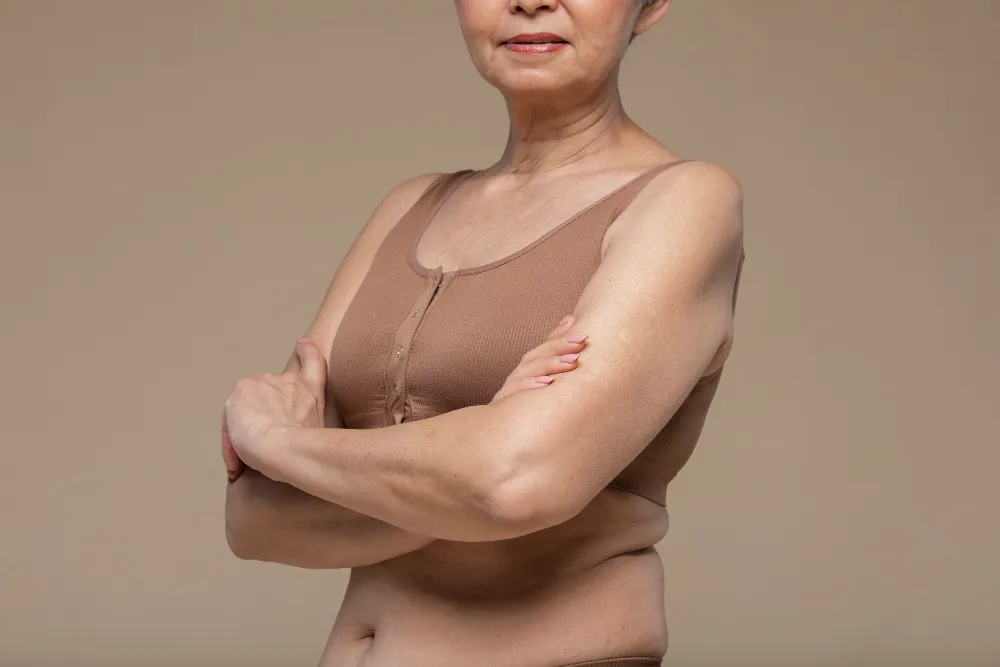
What causes slack skin on inner arms?
Slack skin on the inner arms is usually caused by a combination of aging, loss of collagen and elastin, weight fluctuations, and lack of muscle tone. As we age, the skin naturally loses firmness and elasticity, especially in areas where the skin is thinner, like the inner arms. Significant weight loss can also leave behind stretched skin that doesn’t fully retract. Additionally, a sedentary lifestyle or not engaging the arm muscles regularly can lead to reduced muscle definition, making the skin appear looser.
To improve this area, it’s important to combine strength training exercises (particularly those targeting the triceps and biceps), hydration, balanced nutrition, and in some cases, skincare treatments that support skin firmness.
How long does it take to get rid of bat wings?
Getting rid of ‘bat wings’ takes time and consistency. With regular exercise and good nutrition, arms usually look firmer after 6 to 12 weeks. You can’t reduce fat in just one area, so combining full-body training, cardio, and exercises like dips, push-ups, and triceps extensions is key to achieving gradual but safe results
Why does the tricep area start sagging in women and how to counteract it
The sagging of the tricep area, or “bat wings,” is mainly caused by loss of skin elasticity, reduced muscle tone, and hormonal changes with age. A sedentary lifestyle and weight changes can make it worse. To counteract it, the best approach is strength training, cardio, and good nutrition. Exercises like tricep dips, kickbacks and push-ups help firm the arms, while a protein-rich diet, hydration, and healthy fats support skin and muscle health.
Exercises for flabby underarms
Targeting flabby underarms requires a mix of strength training and consistency. Exercises like tricep dips, push-ups, and tricep kickbacks are especially effective, as they focus directly on the back of the arm where sagging often appears. Including these movements 2–3 times per week can lead to visible improvements over time.
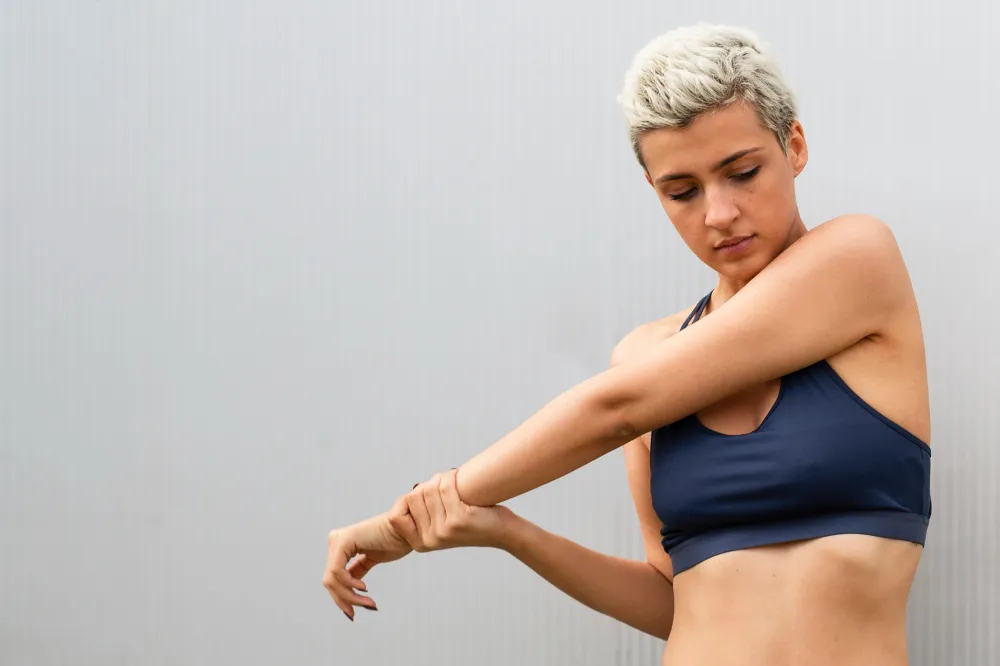
To enhance results, it’s important to combine resistance exercises with compound movements like plank-to-downward-dog or dumbbell chest presses, which also engage the shoulders and upper back. This helps tone the entire upper body and supports better posture, which makes arms appear tighter and more defined.
Remember, spot reduction isn’t possible—but building lean muscle while reducing overall body fat will gradually improve arm definition. Pair these exercises with a balanced diet and hydration, and you’ll notice not only firmer arms, but also a stronger, more sculpted upper body overall.
Band exercises for flabby arms
Resistance bands are an excellent option for toning flabby arms, especially if you’re looking for low-impact exercises you can do at home. They help strengthen the biceps and triceps, improve posture, and enhance stability, promoting a firmer and more defined appearance over time.
Recommended resistance band exercises:
- Tricep extensions
- Bicep curls
- Overhead presses
- Lateral raises
Start with 2–3 sets of 12–15 repetitions using a light to moderate resistance band, and gradually increase the intensity as you gain strength.
Flabby arms diet
Tackle arm flabbiness is not just about exercise; proper nutrition plays a fundamental role. A diet designed for this purpose not only helps reduce overall body fat but also contributes to the health of your arm muscles and skin.
Keys to an Effective Diet
- Lean Proteins: Proteins are the building blocks of muscles. Be sure to include sources like skinless chicken, turkey, fish, eggs, legumes, and tofu in your meals. Adequate protein intake is essential for strengthening the triceps and biceps.
- Healthy Fats: Unsaturated fats, found in foods like avocado, nuts, seeds, and olive oil, are crucial for skin elasticity. These fats help keep your skin hydrated and firm, which is vital for a toned appearance.
- Hydration: Drinking enough water is the simplest and most effective way to keep your skin elastic and radiant. Well-hydrated skin is less prone to showing signs of sagging.
- Fiber and Antioxidants: Foods rich in fiber, such as fruits, vegetables, and whole grains, help maintain a healthy weight by promoting satiety. Meanwhile, antioxidants (vitamins C, E, and A) protect skin from cellular damage and promote collagen production, which improves its firmness.



